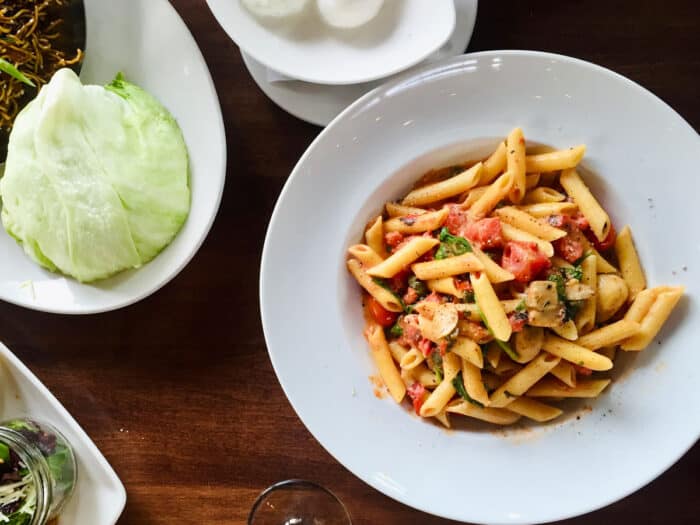
Written By: Gloria Tsang, RD
Title: Founding Registered Dietitian
Alumni: University of British Columbia
Last Updated on:

Italian food is a true favorite for so many people. Who can resist crusty pizza, saucy pasta, and fresh oven-baked garlic bread – not to mention all the fragrant herbs! As a savvy diabetes diner, you can still look for healthy choices and enjoy eating out in an Italian restaurant.

Table of Contents
Whether you like bowtie, angel hair, linguine, or macaroni, the quantity of pasta is where you’d make or break your meal diabetic plan. Let’s face it, when we order pasta, noodles are the main star of the dish. In restaurant, the pasta portion alone takes up at least 80% of the dish. For instance, a serving of fettucini pasta (not including any sauces or meat or vegetables) from Olive Garden provides 64 grams of net carb, that’s more than 4 carb choices already. That is usually the amount of carbohydrates allocated per meal. If you’re just eating that, and not other appetizers or desserts, that’s probably ok. But if add other appetizers such as garlic bread and after-meal desserts, then this meal will be too carb-heavy. Keep your pasta portions moderate by having a small garden salad prior to your main course, then share your entree or ask for a take-out box for the leftovers. Alternately, choose to visit during lunch hours, as most restaurants serve a small portion at lunch.
In addition, think about the sauce as well. White sauce, such as Alfredo sauce, contains parmesan cheese, butter, and oil, which add more calories and fat to pasta dishes than marinara-style tomato sauces. For instance, a serving of Marinara sauce from Olive Garden provides 150 calories, while a serving of their Creamy Mushroom sauce provides 860 calories.
It’s natural to think of pizza when you think Italian. It’s one of the best imports in American history! Most of the carbohydrates in pizza come from the crust; and the thicker the crust, the higher the carb content. So deep dish, “pan,” or Chicago-style pizza is going to pack in more carbohydrates than thinner slices like New York-style.
For instance, two slices of a large Original Pepperoni Pizza from Papa Johns provides 72 grams of net carb. If you switch it to thin crust, 2 slices only clocks in at 38 grams of net carb. That’s almost half the carb!
Many pizza restaurants now offer whole wheat crusts; with higher fiber and protein content, net carb will be lowered. For overall healthy pizza slices keep the toppings light and fresh. Ask for a smaller amount of cheese and opt for more fresh vegetables instead of meat toppings. Take advantage of fresh herbs too! Add oregano, garlic, basil, or spicy crushed pepper for extra zing without extra sodium.
Fresh and tasty ingredients are a big part of Italian cuisine. For people with diabetes the key is to choose vegetables for pizza toppings and side dishes, go for poultry or fish that is grilled or braised, and select sauces that don’t tip the scales in calories, fat and carbs. You can enjoy the full flavor of Italian cuisine without having to compromise your healthy diabetes meal plan.
Alumni: University of British Columbia – Gloria Tsang is the author of 6 books and the founder of HealthCastle.com, the largest online nutrition network run by registered dietitians. Her work has appeared in major national publications, and she is a regularly featured nutrition expert for media outlets across the country. The Huffington Post named her one of its Top 20 Nutrition Experts on Twitter. Gloria’s articles have appeared on various media such as Reuters, NBC & ABC affiliates, The Chicago Sun-Times, Reader’s Digest Canada, iVillage and USA Today.
diabetes, healthy dine-out, italian foods, italian foods for diabetes, italian restaurants, olive garden, papa johns
Excellent information, it helped me decide the healthiest Pizza to buy. I am a diabetic.
Thanks.
Hi Allegra,
Thank you for your note. Glad you found the article helpful. Just in case other diabetes articles may also help you, do check out this section of our website.
https://www.healthcastle.com/tag/diabetes/
Newly diagnosed. 6’2. 211 ponds. (57) I’m not sure why I would put myself in the position of going to an Italian resturaunt going forward. Articles similar to these (which seems to be the only type I can find) seem to be geared for people who are looking for substitutions for what they truly want just to eat in an Italian resturaunt, I can totally appreciate that and respect that. No issue. What about the balance of people (like me) who’s find this type of eating more aggravating then it’s worth, and truly not an enjoyable experience as opposed to just not eating italian food at all?? This goes for all types of cuisines as well. Since being diagnosed I don’t eat any bread of any type.( Not intrested in substituting bread for two reasons 1st, I believe it’s only one slice of a whole grain type which something i can easily live without , and secondly I find it infuriating to do so. I just feel better mentaly not having to be involved with bread , pasta , pizza at all. I cant imagine having the side pasta, sharing it or bringing it home) Where are the articles for people with this afliction that arent intrested in substitutions they have no desire for. ?? Since diagnosed I only eat salad with grilled chicken, viniger and oil at every meal lunch ( which I rarely eat) because I am super busy at work (Electrical Engineer) and dinner. I have cut any and all snack items out of my life. I did read articles with suggestions of chips and cookies and stuff all of which were easy for me to say no to and not look back. Are thier articles with my type of mind set?? That you can suggest ??
Is thier anything I can mix with water and gulp down. I would be good with that too. I do take vitamins to suplement this style of eating. I find eating more like taking medication at this point. Which is how I’m able to deal with it as well as taking any enjoyment derived from eating out. The less I can do and spend time dwelling on food substitutes and choises ithe happier I am.
I just found out I’m type 2 a few weeks ago. What if I’m too addicted to Italian food. Like if Italian food was the only thing available forever then I’d the happiest person alive. But I love my meats and cheeses for toppings. And I love my legit pastas none of this whole grain or other substitute crap. And if I’m at olive garden the waiter better have good arm endurance for the shredded cheese because it will take a long time for me to tell them to stop… Bottom line for me is what am I supposed to do here. Just thinking about having to do thin crust instead of pan or smaller portions instead of the big plate or bowl or less cheese causes me great pains. Like there’s no way I can do this. Part of my brain is like I rather eat all this and die happy as a clam.eating whatever the hell I want than be miserable with these restrictions and this goes with most of the foods amd drinks I like being on the bad list…. I feat this is going to be way too hard of a struggle for me. I alue the food way too much.
I like you have been recently diagnosed w/T2d. I also love Italian cuisine, love to cook it and eat it. I don’t want to feel fiber in my pasta, and love Lou Malanti’s. I can’t imagine not having pasta at least 3 times a week! so that has changed and radically.
As I start this new chapter, I’m restricting myself to 1/4 cup of pasta and only on Saturdays, my treat day. I make my own sauce, which is very friendly to diabetes, so no issues there. I am a chees-oholic, and that is now being measured. All this in an effort to learn the effects of the good stuff on me as I roll along. For the here and future now, at least, I’m in learning mode and will not go back to what I love. Probably never. But I will learn to eat w/restrictions, the things I do enjoy. There is so much to learn; I recommend a diabetic nutritionist (which BTW has been very difficult to find for me, and insurance does not cover..go figure!). Take your first 6-9 months to restrict, research, learn and test. Once you’ve got it down, choices will be easier and manageable, I’m convinced. Plus, if you’re strict right now, you run a good chance of moving that A1C to more acceptable and maybe can manage this beast w/diet! Maybe even remission! Good luck!
I guess I don’t understand the whole no cheese thing. Isn’t parmesan, mozzarella and swiss all okay? My husband (T2D) eats them with no issues.
I am not sure I understand the guidance on avoiding cheese or cured meats, etc, at least from a diabetic perspective. Yes, a diabetic is statistically more likely to get heart disease but the most important aspect is to appropriately manage carbs. So breads, pastas, cereals, sugary drinks, desserts, etc. So here is my advice:
Limit your carb intake. I eat pasta but I know how much and eat other foods as well to balance. Fill up on the other foods but enjoy your pasta. Same thing with sandwiches/panini/etc – be aware of the amount of carbs you eat in the breads. It is directly proportional to the weight of the bread/pasta.
Focus on carbs which are harder to digest, such as whole grain carbs. They will have less of a spike on your blood sugar and give your body/insulin more time to counteract. I have found this especially true for breads.
There is a fair bit of evidence that eating carbs after other foods will slow blood sugar rise. I often start with eating a salad first or the other non-carb items on my plate before getting to my pasta.